In the realm of traditional Jewish wedding ceremonies, few symbols are as iconic as the Chuppah.
Renowned for its rich symbolism and emotional resonance, it’s a staple element engrained in the fabric of matrimonial lore.
But, can a gazebo be a chuppah?
Well, this article explores this intriguing query, delving into the depths of religious scriptures, cultural customs, and architectural interpretations.
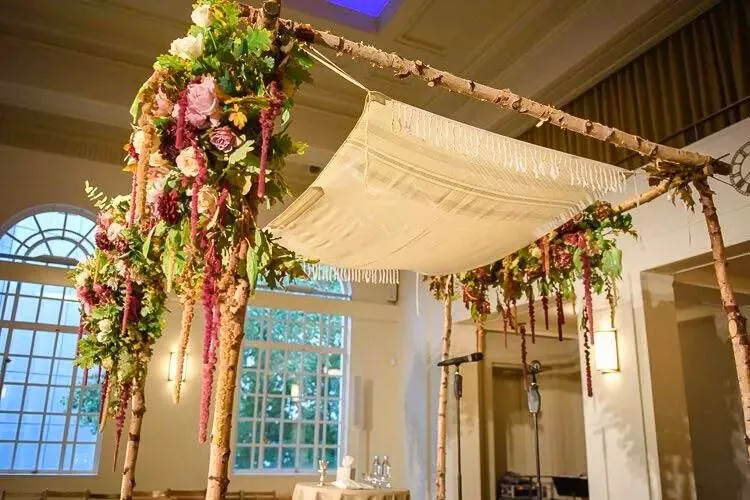
It’s an attempt to demystify the interconnected roles and significance of Gazebos and Chuppahs. Stick around as we navigate this fascinating discourse together.
Contents
Can A Gazebo Be A Chuppah?
Yes, a gazebo can be used as a Chuppah in a Jewish wedding ceremony, provided it meets certain requirements stipulated by Jewish law (Halachah) and tradition.
The Chuppah’s principal purpose is to symbolize the marital home being established by the couple. Traditionally, a Chuppah is a piece of cloth supported by four poles, open on all sides.
However, its exact structure is less rigidly defined in Jewish law, enabling room for interpretation and adaptation.
A gazebo can become a Chuppah if it is open and accessible from all sides, symbolizing the warm, open home the couple intends to create. The material of the gazebo isn’t strictly defined either.
What matters most is that it aligns with the key symbolism. However, like a traditional Chuppah, a gazebo intended for use as a Chuppah should ideally have a cover, symbolizing the divine presence above the couple.
Furthermore, it’s permissible to decorate the gazebo in a similar fashion to a Chuppah, with flowers, foliage, and fabrics, to enhance its symbolism and aesthetic appeal.
To ensure that the gazebo can indeed be considered a Chuppah, it is advised to consult with a Rabbi prior to the ceremony.
As modern Jewish weddings evolve, flexibility in traditions is seen to accommodate individual desires and practical needs, while adhering to the fundamental symbolism.
Using a gazebo as a Chuppah is one such evolution. As the heart of the wedding ceremony, a gazebo-turned-Chuppah can offer structural stability and versatility while maintaining spiritual significance.
What qualifies as a chuppah?
A Chuppah, in the simplest form, is a cloth or canopy supported by four poles. The requirements for a Chuppah are fairly flexible, but it traditionally should:
- Provide a cover or roof
- Be open on all sides
- Represent the home that the couple will establish together
These three things align with the significance of home, hospitality, and divine presence. Even though these are the main requirements, it’s recommended to consult a Rabbi for further personal and precise details.
What is the best size for a chuppah?
There isn’t a universally prescribed “best size” for a Chuppah, as the size largely depends on personal preferences, number of people standing under the Chuppah, and the venue’s space constraints.
However, a common size is approximately 8 feet by 8 feet, providing ample space for the couple, officiant, and parents, while maintaining a sense of intimacy.
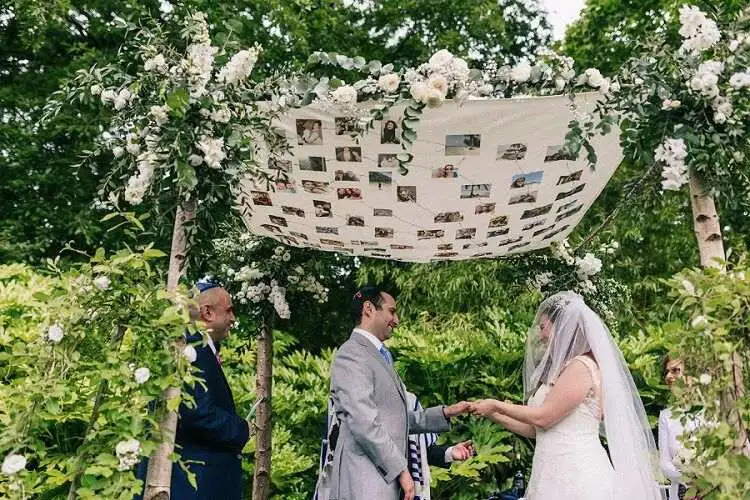
When selecting a suitable Chuppah size, consider the following factors:
- The number of people standing under the Chuppah: Typically, the bride, groom, officiant, and parents will be included, but other family members or the couple’s children might join in certain situations.
- The visual scale and proportions: Ensure the Chuppah corresponds to the room’s size, neither appearing too small and insignificant nor dominating the space.
- Accessibility and functionality: The Chuppah should be easily accessed, and there should be enough room for any wedding rituals that will take place underneath.
Keep in mind that Chuppahs can be customized and tailored to fit the couple’s tastes and preferences. It is crucial to communicate with the venue coordinator, event planner, and Rabbi about the desired Chuppah size, considering both practical and aesthetic concerns.
By ensuring the chosen dimensions meet personal needs and blend harmoniously with the wedding setting, couples can create a memorable, visually pleasing Chuppah that encapsulates the spirit of their union.
Does a chuppah have to be wood?
No, a Chuppah does not have to be made of wood. The Jewish law (Halachah) does not specify a particular material for constructing the Chuppah. It can be made from a variety of materials including wood, metal, or even sturdy plastic.
The essentials of a Chuppah are its four posts and a cloth or canopy top that provides a covering but leaves the sides open. The type of material utilized is secondary to this basic structure and the symbolic meaning it embodies.
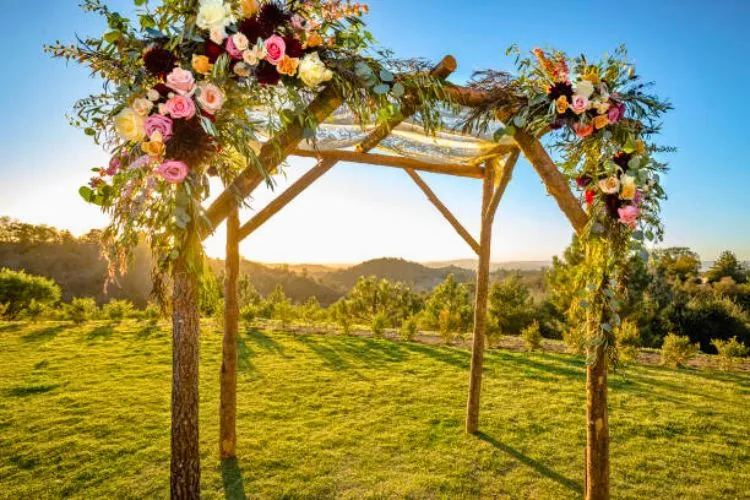
Traditionally, the Chuppah is crafted out of materials that hold personal, aesthetic, or traditional significance to the couple.
For instance, some people choose a tallit (Jewish prayer shawl) as the canopy while others opt for materials that are personally significant such as a family heirloom or handmade cloth.
As always, for any specific religious concerns or queries, it’s best to consult a Rabbi or officiant.
Legal and Religious Considerations for using gazebo as chuppah
When considering legally and religiously using a gazebo as a Chuppah for a Jewish wedding, there are some key points to keep in mind:
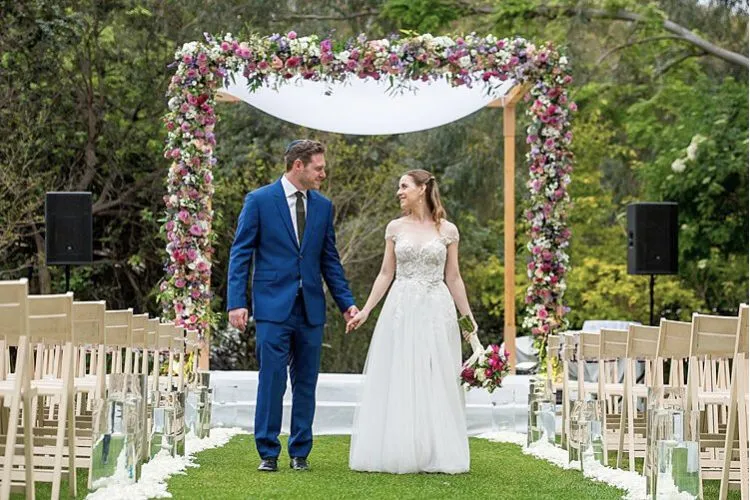
Religious Considerations
- Structure and Openness: A Chuppah represents the couple’s home and is traditionally open on all sides to symbolize hospitality. The gazebo should also be accessible from all sides. If the gazebo has side walls, they should be open or removed.
- Canopy: A gazebo’s existing roof can serve as the canopy, or a cloth can be added over the top. This is crucial as the canopy of the Chuppah symbolizes the divine presence ‘blanketing’ the couple.
- Consultation with a Rabbi: Given that traditions may vary between different Jewish denominations, working closely with your Rabbi to ensure your gazebo meets all necessary religious requirements is advised.
Legal Considerations
- Venue permissions: If you’re using a gazebo located in a public or rented space, ensure that modifications to the structure (temporary or otherwise) are allowed.
- Local regulations: After considering your personal modifications, confirm that your gazebo Chuppah setup aligns with local safety regulations, like maximum occupancy or fire safety rules if using decorations.
- Marriage license: Ensure you have obtained a valid marriage license in accordance with your local jurisdiction’s requirements. These are separate from religious ceremonies and are a necessary legal aspect of getting married.
It’s important to consider both religious and legal aspects when planning to use a gazebo as a Chuppah to ensure a smooth and meaningful ceremony.
What Kind of Gazebo Can Be Used as a Chuppah?
When considering using a gazebo as a Chuppah for a Jewish wedding, several factors will determine its suitability. Here’s what you should consider:
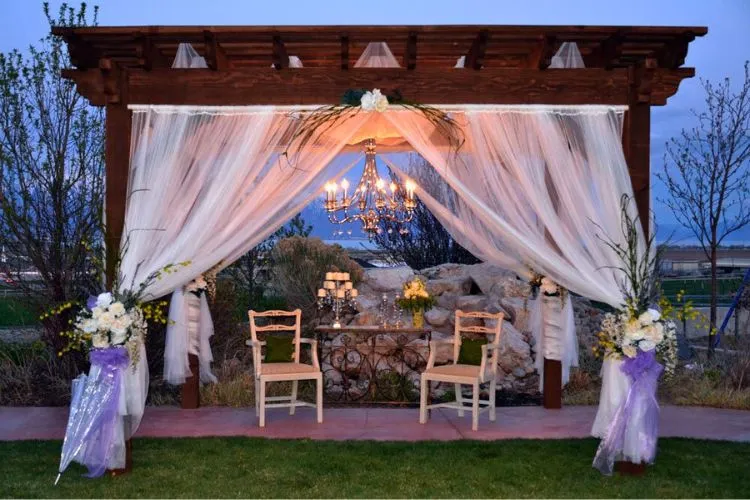
Structure and Size
The gazebo should ideally be open on all sides, which aligns with a chuppah’s traditional representation of an open and welcoming home.
Consider the size of the gazebo – it should be large enough to accommodate the couple, the Rabbi, and any other participants, but not so large that it loses its intimate feel.
Material
There are no specific restrictions on the material of the gazebo. Choose a gazebo made of wood, metal, or any other sturdy material that can support the canopy and withstand outdoor weather.
Canopy
The gazebo’s roof can act as the Chuppah canopy if it’s made of cloth or other movable material. If not, you could add a cloth over the top. Some people use a tallit (Jewish prayer shawl) or a cloth with personal or familial significance.
Flexibility for Decorations
Choose a gazebo that allows for decorations according to your preference and tradition. Flower arrangements, lights, and draperies are common.
Some Jewish traditions involve decorating the Chuppah with fruits and flowers to symbolize a sweet and flourishing marriage.
Compliance with Themes and Aesthetics
Ensure the gazebo fits into your overall wedding theme and aesthetics. The shape, style, material, and color should complement other elements of the wedding.
In all cases, it’s best to consult with your Rabbi or officiant to ensure that the gazebo aligns with the religious requirements of a Chuppah.
Here’s an additional 300 words to further enhance your article before the conclusion, providing practical tips for couples considering using a gazebo as a Chuppah, and discussing the personal significance of this choice:
Tips for Couples Considering a Gazebo as a Chuppah
Using a gazebo as a Chuppah is an innovative and personalized choice for a wedding ceremony. It allows couples to embrace tradition while incorporating their own tastes and practical needs.
Here are some helpful tips to ensure your gazebo functions as a meaningful and beautiful Chuppah.
Consider the Venue and Setting
The location of the wedding ceremony plays a significant role in determining whether a gazebo is a fitting choice. If your ceremony is outdoors, such as in a garden or park, a gazebo can provide both aesthetic appeal and functional shelter.
Be mindful of the surroundings and how the gazebo will blend with the natural environment. A wooden gazebo, for instance, may complement a rustic, garden-themed wedding, while a more modern metal structure might be better suited to an urban setting.
Incorporate Personal Elements
One of the advantages of using a gazebo as a Chuppah is the opportunity to make it truly your own.
Adding personal touches such as family heirlooms, meaningful fabrics, or custom decorations can infuse the space with sentimental value. Some couples choose to adorn the gazebo with floral arrangements, ribbons, or drapes that reflect their cultural or aesthetic preferences.
If you have a favorite flower or a specific color that holds meaning for you, incorporating it into the gazebo’s decoration will make the space feel even more special.
Creating a Memorable Experience
In addition to its symbolic role, the Chuppah serves as the centerpiece of the ceremony. Creating a memorable experience under the gazebo involves thinking beyond the structure itself.
Consider the ambiance that the setting will evoke. The placement of the gazebo, the lighting (such as hanging lanterns or string lights), and the comfort of your guests all contribute to the overall atmosphere.
By thoughtfully planning these details, you can ensure that the ceremony is not only visually striking but also emotionally meaningful.
Conclusion:
A gazebo can indeed serve as a Chuppah in a Jewish wedding ceremony. The key is to ensure that the structure aligns with the core principles of a traditional Chuppah – openness, a cloth canopy, and the ability to accommodate key participants.
Material selection, size, and adaptability for decorations and themes are also essential considerations.
As with any alteration of traditional structures, consultation with a Rabbi or officiant is advised to ensure alignment with religious requirements.
Ultimately, the versatility of a gazebo provides a unique opportunity to integrate personal aesthetics and symbolic significance into this cherished component of the Jewish wedding.

Sergio Gomes, a passionate advocate for outdoor living and the male voice behind Shades Authority. With years of experience, Sergio is your trusted source for expert insights on gazebos, pavilions, cabanas, pergolas, and all things outdoor shade solutions. Join him on a journey to transform your outdoor spaces into stunning, functional retreats
